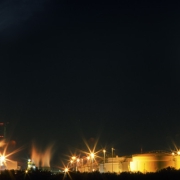Something is lurking beneath those waves
Methane Hydrates are known to the world as burning ice. It is an oddity to the energy industry and easily shrugged off but they are more imminent than many executives like to think. The LNG projects under construction today will bear its scars.
I remember early 2008. The world was still a party. Natural Gas business was the big darling on the block, shale was still an oddity, that the gas world did not really take seriously and at EconGas we were all still self-congratulating for the great GATE deal. But there was also the beginning of an eerie feeling, a feeling that things would not be as nice and cozy as they seemed.
I was about to be entrusted with LNG long-term supply and we had a discussion during which I warned of shale (and was laughed at) if that was not enough I mentioned two words that did not even produce laughs but only incomprehension. Methane Hydrates.
Even in 2008, the core rationale was obvious to me and it has not changed since. LNG became very, very expensive. Japan was (and still is) the biggest LNG importer and it is utterly dependent on this very energy source. They pay a heavy price for it but at the same time, they are sitting on a huge stash of Methane Hydrates. If I was Japanese, I thought by myself, I would pour money into Methane Hydrate research. And that’s what they do.
I have mentioned it in other places in this blog. Any reasonably free economic system abhors constraint and pressure. And when pressure is applied, the economy will wiggle until it finds a way out. That’s what happens to Japan today and just like the shale gas boom has spread through the world from the US, the Methane Hydrate boom will take the planet in a storm.
But, one might ask, isn’t Methane Hydrate located on the seafloor and very hard to lift? For Japan, this is true but not so for the rest of the world.
Looking at this from afar, all the ingredients of the shale gas revolution are here once again. Nobody knows what it costs to exploit Methane Hydrates. It’s an energy frontier and as it is with all frontier work, a proper body of knowledge will have to be established. Until that is, it’s trial and error. And a leading economy of the planet aches under the cost of imported energy.
Shale gas has been known to exist for many decades before commercial quantities of shale gas have been extracted. Fracking also is not exactly a new technology. Neither is lateral drilling.
It was the combination of these technologies with mass industrialization and entrepreneurial spirit that caused shale as we know it today. But why is all this happening now? Why has shale happened now? Why is the world waking up the Natural Gas as a transport fuel?
Some say because mankind is somehow ready for it. It’s time for an energy leap of proportions. Others say that some lunatics brought this upon us by trying to turn the clock back on even more environmentally friendly energies.
I say that it’s good old entrepreneurial thinking combined with the will to exploit an opportunity when it presents itself. High energy prices are such an opportunity. Entrepreneurs love high prices, as they make investments worthwhile which would not happen otherwise.
Do you believe that shale would have happened if oil had hovered at 30 bucks or close to it for the last 10 years? Or even at 50 greens? No way. Nobody would have jumped the opportunity, as there was none.
The problem is that, even if today it is clear that shale is a viable proposition at even lower oil prices, that was not so obvious as recently as 10 years ago. The industry still did not have a good idea of what shale exploration is going to cost in the end. As recent as 2007 I had seen numbers as diverse as 12 up to 30 dollars per MMBtu.
But at natural gas price levels of 20 greenbacks and more, some guess that given some technology improvements, the cost of lifting shale could be lowered enough to make it a viable business. I am sure that not even in their wildest dreams they had contemplated a fall to 3 bucks or less.
That same mechanic is at play in Methane Hydrates now. It’s where shale has been in 2002, at its very beginnings. If the analogy holds up, we will be basking in huge quantities of Natural Gas early in the 2020ies. And it will be cheap.
Why should the LNG industry take note? Well, simply because classically LNG projects are financed and written off over very long periods (20 years is not odd) and over this period the project is very sensitive to any change in the sales market.
Some Australian projects will go into production over the next couple of years. They are among the most expensive energy projects that adorn the planet. They will require a very stable sales situation until 2035 and beyond and they were all banking on the Asian bumper market to last forever.
The very prospect of LNG from US shale already sends jitters to those projects as their projections start cracking all over. Imagine Methane Hydrates to take off big. Suddenly Japan and other Asian countries have their version of patriot fuel. And plenty of it, so much in fact that some Japanese terminals might even consider exporting LNG to then hard-pressed European markets as the clean fuels mechanics in place will amplify the need for new Natural Gas there.
But that is wild speculation. I don’t know what tomorrow brings so 10 years from now is a total mystery. But after shale, will you dare me by saying that it’s impossible?
Nothing beats human inventiveness. I have stressed Julian Lincoln Simons’s core message in his book “The Ultimate Resource II” more than once on this blog and I will no doubt do it many more times. Constraint is an opportunity for entrepreneurs. They seek profits when they go and search for alternatives – any alternatives. Ultimately, some entrepreneurs find solutions that will leave humanity as a whole better off than if the original problem had never occurred in the first place.
High oil prices, high energy prices, and the “pie in the sky” projects of environmental ultras have put humanity in a tight corner. This was the problem and provided the opportunity – call it incentive – for entrepreneurs to put in money and effort to find a way out. Not to improve mankind’s condition but only out of monetary interest. Shale and Methane Hydrates or indeed LNG as a fuel are all part of a solution.
There will no doubt be more. But what is the message to energy producers?
Divvying up the world does not work – at least not for a long time. If you believe that you have the world by the balls, that you have something that cannot be replaced, you are wrong. You are always wrong. It might work for a couple of years and might give you a couple of bumper years. But always remember that this also carries the stench of death.
I was born into a world with a certain order. It dictated that oil comes – among other places – primarily from Saudi Arabia and similar places. In my youth, Oil Arabs were immeasurably rich people and the developed world had to court them no matter what as they needed the oil.
Today, it’s already very different. The developed world starts to unhook itself from the classic primary energy producers and becomes much more independent – at least in energy terms. And by the same token, it saves the environment.
The oil-producing nations have produced swelling populations and a thirst for energy that’s so gargantuan that we might see the prospect of some of them becoming energy importers. This is already the case with Egypt and soon the Emirates. There will be more. Saudi Arabia is going after shale to meet the incredible thirst for air conditioning of its native folks.
Suddenly the thing that provided them with plenty of cash in the past becomes a huge burden in their national budgets.
From what I can glean of Methane Hydrates, they are so abundant that the planet could run on them for thousands of years. A geologist once told me that if we compared all oil and gas that has been produced on earth since man uses them plus all the conventional oil and gas still in the earth’s crust to the amount of Methane Hydrates available, Methane Hydrates make more than 95%. I don’t know if this number is realistic, but the proportions certainly are.
An age of cheap, clean, and plentiful energy beckons brought upon us not by some superior intellect but rather by need, pain, and the will to gain profit from those situations.


















I’m guessing Japan will be using commercial quantities of methane hydrates within 3 years. And the technology they use will benefit, or benefit from the technology to mine the layer of rare earth metals found near the ocean floor.
http://www.theregister.co.uk/2013/03/25/japan_rare_earth_discovery_bad_news_china/
This is a very interesting perspective to Methane Hydrates. Thank you. I need to do more digging here.
Hi Rudi – Japan has just successfully completed the first pilot extraction of deep sea methane hydrates in last month or so. It will take time to scale up to full production level capability and as we know most times the first scale up doesn’t work how we think it would so I think 3 years is very optimistic from other comment ……… 10 years more realistic ….. but I agree with your premise that Japan will use this “local” abundant gas. Interesting points will be cost of production/ extraction which will be very high but whatever it will hit the global LNG industry although if Japan is locked in to 15 to 20 year contracts it will probably be a ramping “take over” as these contracts mature and are not renewed. See you somewhere!! Leigh.